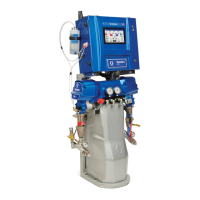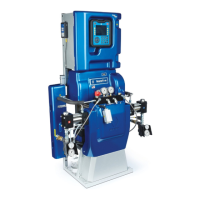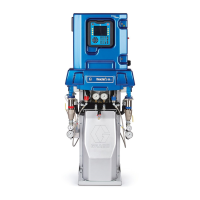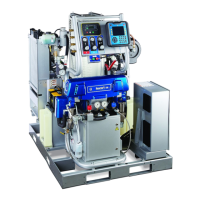Setup
Grounding
The equipment must be grounded to reduce the
risk of static sparking and e lectric shock. Electric
or static sparking can cause fumes to ignite or
explode. Improper grounding can cause electric
shock. Grounding p rovides an esc ape wire for the
electric current.
•
Reactor Sys tem:
System must be grounded with
an appropriately s ized conductor to the traile r
or vehicle chassis or, if stationary, to true earth
ground. Remove bolt and braided cable from
pallet. Install grounding cable terminated wi th a
ring te rminal (cab le and terminal n ot supplied)
under b raided cab le. Reinstall bolt and torque
to minimum 25 ft-lbs (34 N∙m). An alternate
grounding location is to the ground bar in the
electrical enclosure. Follow all National, State, and
Local safety and fire codes.
•
Spray gun:
connect whip hose ground wire to FTS.
See Install Fluid Temperature Sensor, page 43.
Do not disconnect ground wire or spray without
whip hose.
•
Fluid supply containers:
follow your local code.
•
Object being sprayed:
follow your local code.
•
Solvent pails used when flushing:
follow your local
code. Use only metal pails, which are conductive,
placed on a grounded surface. Do not place pail
on a nonconductive surface, such as paper or
cardboard, which interrupts grounding continuity.
•
To maintain grounding c ontinuity when flushing o r
relieving pressure,
hold a metal part of sp ray gun
firmly to the si de o f a ground ed
metal
pail, then
trigger gun.
332636D 45

